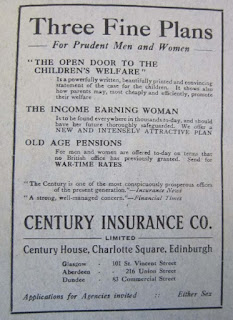This week, Louise concludes her series of blogs on the role
of women in medicine in our region during the First World War. Her last blog
looked at women serving on foreign battlefields, but she has discovered that a
posting in one of Edinburgh’s military hospitals brought experiences mentally
(and sometimes physically!) far from home too:
For the nursing staff of Scottish military hospitals during
the First World War, there were many rude awakenings. For
professional, hospital-trained nurses, the influx of casualties must have been
a shock, along with the injuries that came as a result of mechanised warfare on
a mass scale. Some hospitals specialised in the horrific injuries that trench
warfare brought, such as Edenhall Hospital for Limbless Sailors and Soldiers
(sited at Pinkieburn, Musselburgh from early 1918). Edenhall developed and made
mobility aids onsite - you can see some at the front of this photo:
 |
| Patients and staff at Edenhall, c. 1917,(Acc 12/054) |
For volunteer nurses drafted in for wartime needs (Voluntary
Aid Detachment nurses trained by the Red Cross in basic skills – VADs), the
comparisons with life before the war must have been even more stark. Not only
did most women enter the working world for the first time and lived away from
the family home, but they were also exposed to the male-dominated life of the
ward, with bodies, blood and bone becoming commonplace sights for them.
But serving in a Scottish military hospital did not
necessarily mean seeing out the war on the home front. Having gained experience
in caring for soldiers at home, nurses, doctors and orderlies from hospitals
around Edinburgh were called to serve abroad. For staff at the 2nd
General Hospital, Craigleith, this sometimes meant serving in the Mediterranean
Expeditionary Force in North Africa. Here are Territorial Force Nursing Service
(TFNS) nurses and Royal Army Medical Corps members taking time away from duty
at the pyramids in Egypt in a photograph sent back to be published in the hospital
magazine, the Craigleith Hospital
Chronicle:
 |
| Craigleith staff in Egypt, 1916 (GD1/82/12) |
TFNS nurses were professionally training nursing
staff, who volunteered to care for the wartime territorial forces (that is, those who volunteered to
fight rather than professional soldiers). I think that that these particular nurses
are TFNS nurses (rather than VADs) on account of their uniforms. There’s more
on military nursing uniforms on the excellent Scarlet Finders site, here.
Camels in Egypt were not just for fun. In 1916, a Scottish
medic serving in the military hospitals sent the Craigleith Hospital Chronicle this article:
 |
| Article heading, 1917 (GD28/6) |
The author mentions the very important transport roles that
camels played in military life, and the need for regular rest from the
punishing life of a working animal:
“They are being used in thousands as transport to carry
food, ammunition etc…Within five minutes walk of my home… there is an enormous
rest camp where they get treatment, food and rest…. In the Camp there is a
dipping tank like those used in Scotland for dipping sheep…”
The end of the war did not bring respite for the hardworking
nurses of the 2nd General Hospital, Craigleith, who were to have one
last adventure – sailing from Leith to Danzig to bring back sick and wounded
prisoners of war. Again from the Craigleith
Hospital Chronicle, we learn that a nursing sister and three staff nurses
spent a total of eight weeks on board their ship, the Western Australia, during
December 1918 and January 1919:
 |
| Article illustration and caption, 1919 (GD28/6) |
They witnessed the relief at war’s end, and saw the results
of its horrific effects, as this quotation shows – which must have been quite a
shock for these middle-class women, even if they were hardened by their military hospital experiences:
“Next day we see Russian prisoners being transferred from
barges to ships with Waffenstillstand and Armistice painted on
them. We see the Russians scraping the decks and winches with their knives for
fat, and eating it.” Staff-Nurse E D
Robertson
The article also mentions events that
would shape the world to come. For example, Nurse Robertson reports
that different attempts to evacuate British former prisoners of war from Germany
were hampered by the start of the 1918 November Revolution (which would eventually
lead to the Weimar Republic).
One of the strongest things that
you see in the Craigleith Hospital Chronicle is how life must have changed
for women as a result of their wartime experiences. We often think of
auxiliaries in terms of the Second World War, but this poem shows that women played a crucial support role from 1914 to 1918 for the Army (WAACs), Navy (Wrens) and Women’s Royal Air Force (Penguins - because they did not fly!):
 |
| Craigleith Hospital Chronicle poem, 1918 (GD28/6) |
And this advertisement for
insurance for the ‘income earning woman’ simply would not have existed before
the war:
 |
| Craigleith Hospital Chronicle advertisement, 1918 (GD28/6) |
The lighthearted humour in the
Chronicle also reveals more than it may have originally intended. Times were changing for
women just as they were coming into the workplace in great numbers out of the
necessity of warfare. This cartoon, although undoubtedly in poor taste, hints at this change, as well
as displaying not a little bit of apprehension at a world that looked to be
turning upside down. It reads:
"PTE. MURPHY (who is to be kept without food for 24 hours), as Nurse passes him: 'Shure, Nurse, dear, I hope they don't think I'm a Suffragette.' "
"PTE. MURPHY (who is to be kept without food for 24 hours), as Nurse passes him: 'Shure, Nurse, dear, I hope they don't think I'm a Suffragette.' "
 |
| Craigleith Hospital Chronicle cartoon, 1918 (GD28/6)ption |

No comments:
Post a Comment